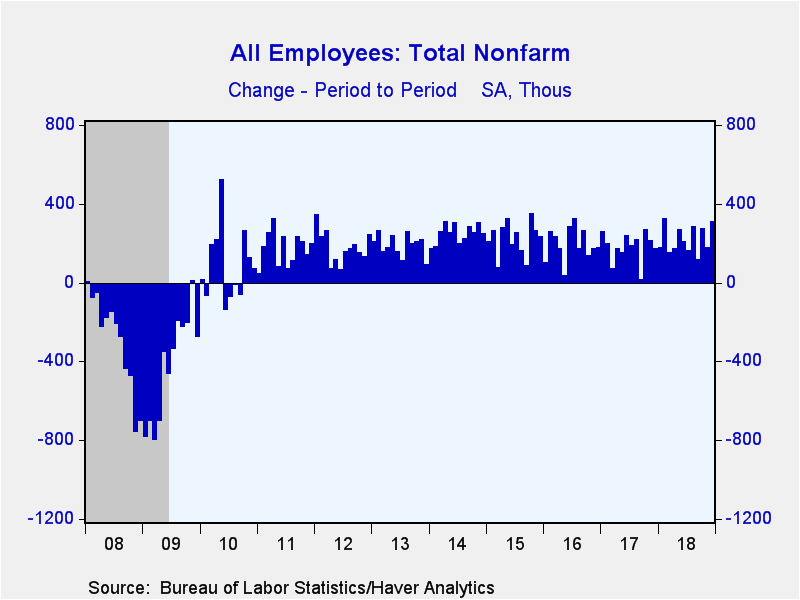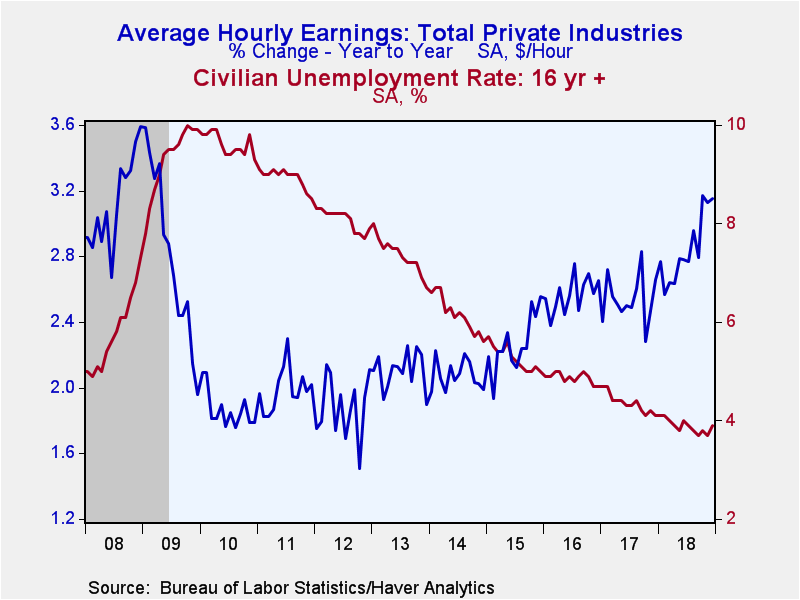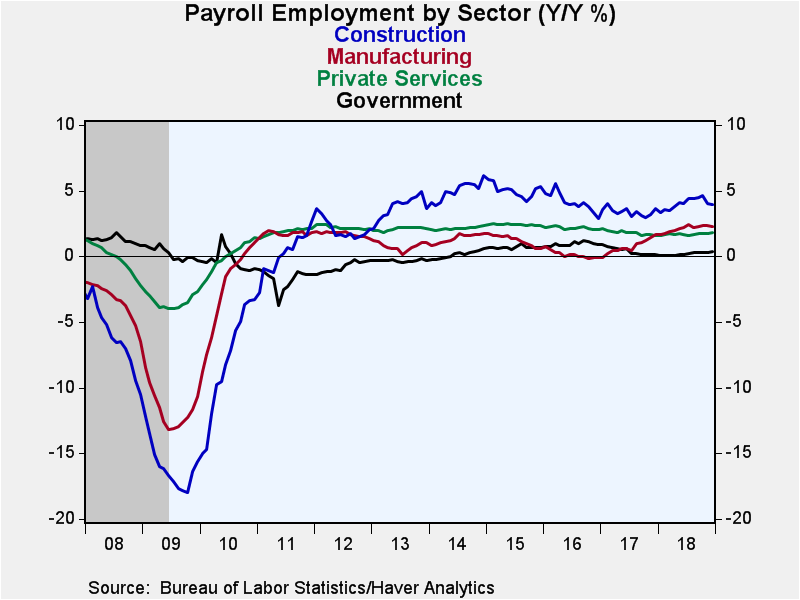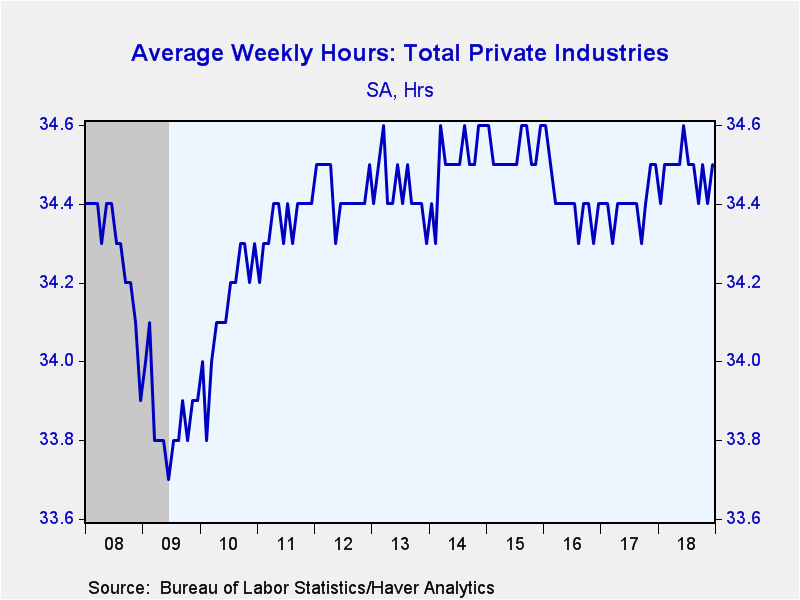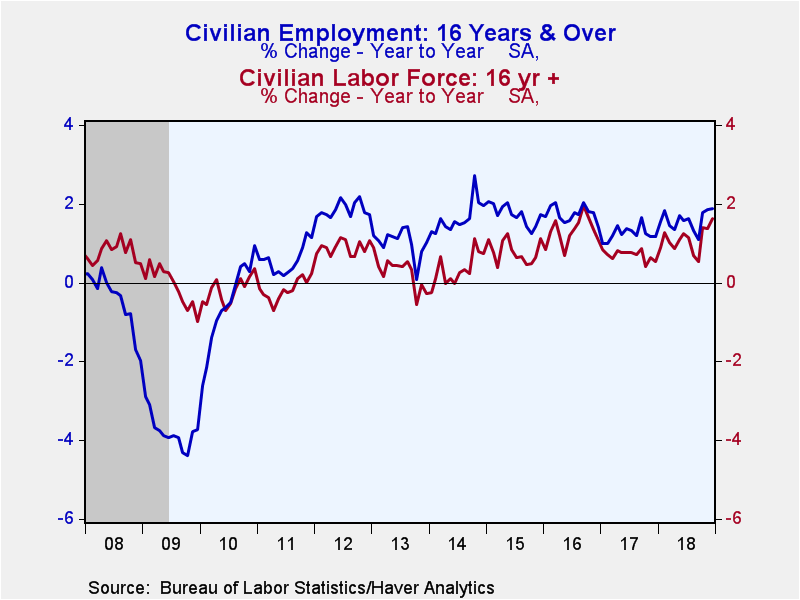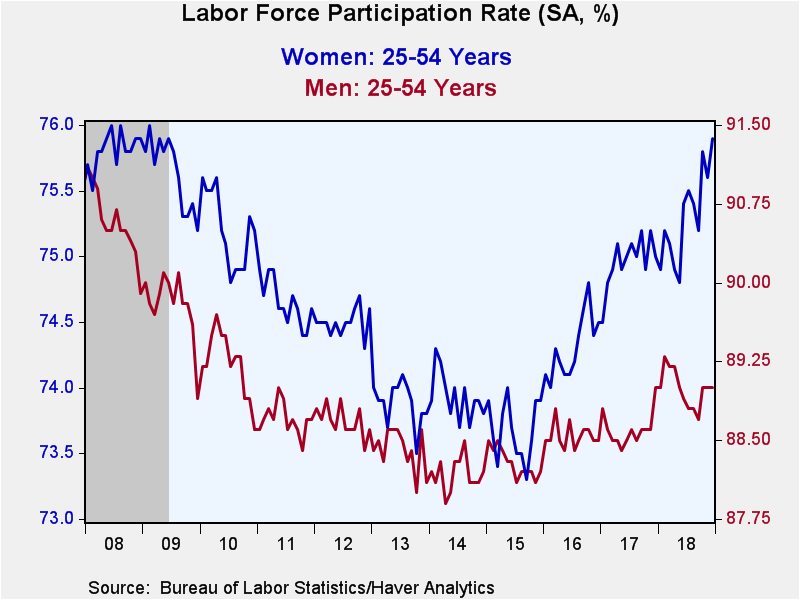 Global| Jan 04 2019
Global| Jan 04 2019U.S. Employment and Earnings Strengthen in December
by:Tom Moeller
|in:Economy in Brief
Summary
The labor market finished 2018 on a firm footing. Nonfarm payrolls increased 312,000 (1.8% y/y) during December after a 176,000 November rise, revised from 155,000. October's gain also was revised up to 274,000 from 237,000. The [...]
The labor market finished 2018 on a firm footing. Nonfarm payrolls increased 312,000 (1.8% y/y) during December after a 176,000 November rise, revised from 155,000. October's gain also was revised up to 274,000 from 237,000. The December increase exceeded expectations for a 195,000 rise in the Action Economics Forecast Survey. During all of last year, payrolls grew an average 220,000 per month following a 182,000 monthly average in 2017. It was the strongest 12-month gain since 2015. Average hourly earnings strengthened 0.4% during December following two months of 0.2% increase. A 0.3% rise had been expected. The 3.2% y/y increase matched the strongest 12-month gain since April 2009. The unemployment rate increased to 3.9%, the highest level since July. Stability at 3.7% had been expected.
From the payroll employment survey, the 312,000 increase in jobs reflected a 38,000 gain (4.1%) in construction sector employment which was the strongest increase since February. Factory sector payrolls also were strong, rising 32,000 (2.3% y/y), the biggest monthly gain in twelve months. Employment in the mining & logging sector improved a modest 4,000 (8.4% y/y), down from the 11,000 peak monthly gain logged in April 2017.
Private service sector employment improved 227,000 (1.8% y/y), the strongest gain since October 2017. The rise was paced by an 82,000 increase (2.2% y/y) in education & health services jobs, which was the strongest gain in roughly six years. Leisure & hospitality employment grew a strengthened 55,000 (2.0% y/y). The number of professional & business services jobs grew a steady 43,000 (2.8% y/y) including a 10,300 rise (3.3% y/y) in temporary help jobs, up from little growth early this year. Trade, transportation & utilities jobs improved 34,000 (1.3% y/y) which included a strengthened 23,800 gain (0.5% y/y) in the retail trade sector. Financial activities employment increased a modest 6,000 (1.3% y/y) but employment in the information sector eased 1,000 (-0.8% y/y).
Government sector employment strengthened 11,000 (0.4% y/y) reflecting a 9,000 increase (0.4% y/y) in local government jobs. State government employment improved 5,000 (0.2% y/y) after two months of decline. Offsetting these gains was a 3,000 decline (+0.3% y/y) federal government jobs, which was the first decline in nine months.
Average hourly earnings increased 0.4% (3.2% y/y) led by a 0.5% gain (3.9% y/y) in construction sector earnings. Factory sector earnings grew 0.3% (2.0% y/y). The 0.4% rise (3.2% y/y) in service-producing sector earnings was paced by as 0.7% gain (3.3% y/y) in the trade, transportation & utilities sector and a like increase in information sector earnings (5.7% y/y). Financial activities earnings grew 0.4% (4.1% y/y) while leisure & hospitality earning also rose 0.4% (3.7% y/y). Education & health sector earnings ticked 0.1% higher (2.3% y/y).
The length of the average workweek extended to 34.5 hours as mining sector hours rose to 46.0. Factory sector hours grew to 40.9 hours and the construction sector workweek lengthened to 39.5 hours. The length of the private service sector workweek held steady at 33.3 hours reflecting a lessened 34.4 hours in trade, transportation and public utilities. Financial activities hours eased to 37.5 but professional & business services hours rose to 36.2. Education & health sector hours improved to 33.0 per week but leisure & hospitality hours held steady at 26.0 hours.
From the household employment survey, the higher 3.9% unemployment rate reflected a 142,000 rise in employment which lagged a 419,000 increase in the labor force. The labor force participation rate rose to 63.1%, its highest level since September of 2017 and up from a recent low of 62.7%. The number of workers not in the labor force grew just 0.2% y/y. The unemployment rate, including those who are marginally attached and working part-time for economic reasons, held steady at 7.6%. The labor force participation rate for those aged 25-54 edged up to 82.3%. For men of that age, it held steady at 89.0% but for women it rose to 75.9%, up from 73.7% during all of 2015. The average duration of unemployment inched up to 21.8 weeks.
The unemployment rate for those with less than a high school diploma edged up to 5.8%. For high school graduates but no college, it was 3.8%. For those without a college degree, the unemployment rate was 3.3%. For individual with a college degree, the unemployment rate was 2.1%.
By age group, individuals aged 16-24 were 8.7% unemployed, while for those aged 20-24, the jobless rate was 7.2%. Individuals aged 25-54 years old were 3.2% unemployed while for those over age 55 were 2.9% without work.
The labor market data are contained in Haver's USECON database. Detailed figures are in the EMPL and LABOR databases. The expectations figures are in the AS1REPNA database.
| Employment: (SA, M/M Change, 000s) | Dec | Nov | Oct | Dec Y/Y | 2018 | 2017 | 2016 |
|---|---|---|---|---|---|---|---|
| Payroll Employment | 312 | 176 | 274 | 1.8% | 1.6% | 1.6% | 1.8% |
| Previous Estimate | 155 | 237 | -- | -- | -- | ||
| Manufacturing | 32 | 27 | 29 | 2.3 | 2.1 | 0.7 | 0.1 |
| Construction | 38 | 0 | 31 | 4.1 | 4.0 | 3.4 | 4.1 |
| Private Service-Producing | 227 | 146 | 217 | 1.8 | 1.7 | 1.8 | 2.2 |
| Government | 11 | 3 | -7 | 0.4 | 0.2 | 0.4 | 0.9 |
| Average Weekly Hours - Private Sector | 34.5 | 34.4 | 34.5 | 34.5 | 34.5 | 34.4 | 34.4 |
| Private Sector Average Hourly Earnings (%) | 0.4 | 0.2 | 0.2 | 3.2 | 2.8 | 2.5 | 2.6 |
| Unemployment Rate (%) | 3.9 | 3.7 | 3.8 | 4.1 | 3.9 | 4.4 | 4.9 |
Tom Moeller
AuthorMore in Author Profile »Prior to joining Haver Analytics in 2000, Mr. Moeller worked as the Economist at Chancellor Capital Management from 1985 to 1999. There, he developed comprehensive economic forecasts and interpreted economic data for equity and fixed income portfolio managers. Also at Chancellor, Mr. Moeller worked as an equity analyst and was responsible for researching and rating companies in the economically sensitive automobile and housing industries for investment in Chancellor’s equity portfolio. Prior to joining Chancellor, Mr. Moeller was an Economist at Citibank from 1979 to 1984. He also analyzed pricing behavior in the metals industry for the Council on Wage and Price Stability in Washington, D.C. In 1999, Mr. Moeller received the award for most accurate forecast from the Forecasters' Club of New York. From 1990 to 1992 he was President of the New York Association for Business Economists. Mr. Moeller earned an M.B.A. in Finance from Fordham University, where he graduated in 1987. He holds a Bachelor of Arts in Economics from George Washington University.


